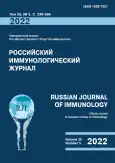Morphological and functional characteristics of LPS-stimulated microglial cells under the action of orexin A
- Authors: Synchikova A.P.1, Korneva E.A.1
-
Affiliations:
- Research Institute of Experimental Medicine
- Issue: Vol 25, No 3 (2022)
- Pages: 333-338
- Section: SHORT COMMUNICATIONS
- URL: https://journal-vniispk.ru/1028-7221/article/view/120218
- DOI: https://doi.org/10.46235/1028-7221-1144-MAF
- ID: 120218
Cite item
Full Text
Abstract
Interest to the orexin-containing neurons is caused by their recent discovery and perspectives of their usage for treatment of different diseases. The studies in this area were launched recently and are of special interest since the opportunity of modulating functional activity of the brain immune system is of pivotal significance for therapy of various central nervous system (CNS) disorders providing novel ways of search and promising data on therapeutic effects of orexins in inflammatory, autoimmune diseases as well as malignant tumors.
Some data from literature show that orexins may exert therapeutic effects in different disorders caused by altered neuroimmune interactions. Participation of this neuromediator system is shown in pathogenesis of narcolepsia, obesity, multiple sclerosis, Alzheimer disease, intestinal disorders, septic shock and cancer, due to involvement of orexins in functional regulation of various components of immune syste, e.g., microglial cell populations. Despite only scarce data on these effects, some experimental results obtained over last years, add to our understanding of orexin effects upon functional activity of the brain immune system.
A number of previous studies allowed to assess the orexin effects on morpho-functional features of microglial cells activated by lipopolysaccharide (LPS), thus presenting a prospective for development of novel approaches to therapy of infectious, inflammatory, neurodegenerative and autoimmune disorders affecting CNS. In the present study, we aimed for detecting the effects of neuromediator orexin A upon functional traits of of microglial cells activated by LPS (M1 phenotype) as evaluated by changes of their size and length of their processes, as well as density of cell distribution.
We have studied the changes of microglia cell numbers following intraperitoneal LPS injection. It was shown that, the LPS causes higher activation degree of these cells, i.e., the contents of microglial cells becomes increased in somatosensory area of the brain cortex. A series of these studies allowed us to demonstrate that intracerebroventricular injection of orexin A in animals following LPS injection does not cause detectable changes of the processes initiated by LPS. The comparative analysis did not detect any changes in length of microglial processes localized in somatosensory or motor cortical areas, and corpus striatum. Other parameters of the microglial cell activation will be studied in future.
Full Text
##article.viewOnOriginalSite##About the authors
A. P. Synchikova
Research Institute of Experimental Medicine
Author for correspondence.
Email: 9410206@gmail.com
Postgraduate Student, Department of General Pathology and Pathogolical Physiology
Russian Federation, St. PetersburgE. A. Korneva
Research Institute of Experimental Medicine
Email: 9410206@gmail.com
Professor, Full Member, Russian Academy of Sciences, Chief Research Associate, Department of General Pathology and Pathogolical Physiology
Russian Federation, St. PetersburgReferences
- Becquet L., Abad C., Leclercq M., Miel C., Jean L., Riou G., Couvineau A., Boyer O., Tan Y.-V. Systemic administration of orexin A ameliorates established experimental autoimmune encephalomyelitis by diminishing neuroinflammation. Neuroinflammation, 2019, Vol. 16, 64. doi: 10.1186/s12974-019-1447-y.
- Biber K., Möller T., Boddeke E., Prinz M. Central nervous system myeloid cells as drug targets: current status and translational challenges. Nat. Rev. Drug Discov., 2016, Vol. 15, no. 2, pp. 110-124.
- Daria A., Colombo A., Llovera G., Hampel H., Willem M., Liesz A., Haass C., Tahirovic S. Young microglia restore amyloid plaque clearance of aged microglia. EMBO J., 2016, Vol. 36, no. 5, pp. 583-603.
- DeCoursey T.E., Morgan D., Cherny V.V. The voltage dependence of NADPH oxidase reveals why phagocytes need proton channels. Nature, 2003, Vol. 422, no. 6931, pp. 531-534.
- Dheen S.T., Kaur C., Ling E.A. Microglial activation and its implications in the brain diseases. Curr. Med. Chem., 2007, Vol. 14, no. 11, pp. 1189-1197.
- España R.A., Baldo B.A., Kelley A.E., Berridge C.W. Wake-promoting and sleep-suppressing actions of hypocretin (orexin): basal forebrain sites of action. Neuroscience, 2001, Vol. 106, no. 4, pp. 699-715.
- Gaykema R.P.A., Goehler L.E. Lipopolysaccharide challenge-induced suppression of Fos in hypothalamic orexin neurons: their potential role in sickness behavior. Brain Behav. Immun., 2009, Vol. 23, no. 7, pp. 926-930.
- Kettenmann H., Hanisch U.K., Noda M., Verkhratsky A. Physiology of microglia. Physiol. Rev., 2011, Vol. 91, no. 2, pp. 461-553.
- Nishino S., Fujiki N., Ripley B., Sakurai E., Kato M., Watanabe T., Mignot E., Yanai K. Decreased brain histamine content in hypocretin/orexin receptor-2 mutated narcoleptic dogs. Neurosci. Lett., 2001, Vol. 313, no. 3, pp. 125-128.
- Paolicelli R.C., Bolasco G., Pagani F., Maggi L.,Scianni M. Synaptic pruning by microglia is necessary for normal brain development. Science, 2011, Vol. 333, no. 6048, pp. 1456-1458.
- Peyron C., Tighe D.K., van den Pol A.N., de Lecea L., Heller H.C., Sutcliffe J.G., Kilduff T.S. Neurons containing hypocretin (orexin) project to multiple neuronal systems. J. Neurosci., 1998, Vol. 18, no. 23, pp. 9996-10015.
- Ransohoff R.M. How neuroinflammation contributes to neurodegeneration. Science, 2016, Vol. 353, no. 6301, pp. 777-783.
- Rock R.B., Peterson P.K. Microglia as a pharmacological target in infectious and inflammatory diseases of the brain. Neuroimmun. Pharmacol., 2006, Vol. 1, no. 2, pp. 117-126.
- Thanos S. The Relationship of microglial cells to dying neurons during natural neuronal cell death and axotomy-induced degeneration of the rat retina. Eur. J. Neurosci., 1991, Vol. 3, pp. 1189-1207.
- Wei R., Jonakait G.M. Neurotrophins and the anti-inflammatory agents interleukin-4 (IL-4), IL-10, and IL-11 and transforming growth factor-B1 (TGF-B1) down-regulate T cell costimulatory molecules B7 and CD40 on cultured rat microglia. Neuroimmunol., 1999, Vol. 95, no. 1-2, pp. 8-18.
Supplementary files









